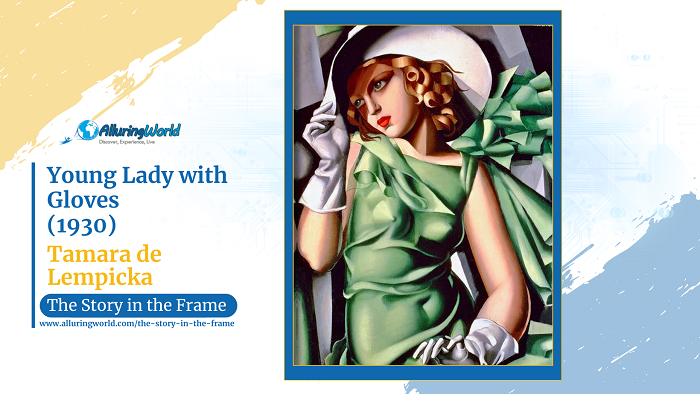Young Lady with Gloves, painted by Tamara de Lempicka in 1930, is a prime example of her distinctive Art Deco style, characterized by elegance, glamour, and modernity. The painting captures a poised and sophisticated woman, reflecting the spirit of independence and refinement that defined the era where with its bold contrasts, smooth textures, and striking composition, this portrait remains one of de Lempicka’s most celebrated works.
About the Painter:
Tamara de Lempicka (1898–1980) was a Polish-born artist who became one of the most iconic painters of the Art Deco movement. After leaving Russia during the Revolution, she found success in Paris, where her sleek and sensual portraits of high society figures earned her international recognition, and blending Cubism with classical influences, de Lempicka developed a unique visual language that celebrated the beauty and power of modern women.
Inspiration and Reasons Behind the Painting:
Young Lady with Gloves embodies de Lempicka’s fascination with the changing role of women in the early 20th century. The painting reflects themes of confidence, self-assurance, and sophistication, capturing the allure of the fashionable and independent women of the time, and as De Lempicka was heavily influenced by contemporary fashion, her portraits often emphasized clothing and accessories as extensions of personality and status. The gloves, hat, and stylish outfit of the subject reinforce the image of an elegant and empowered woman.
What is Depicted in the Painting:
The painting features a strikingly beautiful young woman, dressed in a silky, light-colored gown that drapes smoothly over her form, and her wide-brimmed hat casts a slight shadow over her face, adding an air of mystery. She wears delicate white gloves, drawing attention to her slender, graceful hands, and her gaze is direct, yet slightly detached, exuding a cool confidence. The structured background and sharp folds of fabric enhance the Art Deco aesthetic, creating a perfect balance between softness and geometric precision.
Colors and Techniques:
De Lempicka’s signature style is evident in her meticulous use of color and shading. The painting features a cool-toned palette, dominated by soft whites, grays, and blues, with subtle variations in tone that create a sense of depth and movement. The rendering of fabric, skin, and accessories is smooth and polished, almost sculptural in its precision, but highlights and shadows are carefully placed to enhance the subject’s features, giving the portrait a luminous, almost cinematic quality. The controlled brushwork and crisp edges reflect de Lempicka’s mastery of Art Deco aesthetics, where luxury and modernity coexist seamlessly.
Conclusion:
In conclusion, Young Lady with Gloves remains one of de Lempicka’s most iconic works, embodying the grace and sophistication of Art Deco portraiture. The painting continues to captivate viewers with its refined elegance and timeless beauty, and de Lempicka’s influence extends beyond fine art, inspiring fashion, photography, and contemporary design. This masterpiece stands as a symbol of the confident and stylish women of the 20th century, making it a lasting tribute to the power of femininity and modernity.

